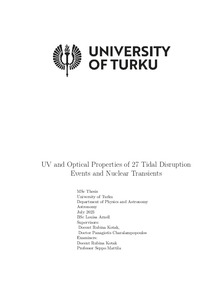UV and Optical Properties of 27 Tidal Disruption Events and Nuclear Transients
Arnell, Louisa (2023-08-21)
UV and Optical Properties of 27 Tidal Disruption Events and Nuclear Transients
Arnell, Louisa
(21.08.2023)
Julkaisu on tekijänoikeussäännösten alainen. Teosta voi lukea ja tulostaa henkilökohtaista käyttöä varten. Käyttö kaupallisiin tarkoituksiin on kielletty.
avoin
Julkaisun pysyvä osoite on:
https://urn.fi/URN:NBN:fi-fe20231006139216
https://urn.fi/URN:NBN:fi-fe20231006139216
Tiivistelmä
I explore the UV/optical properties of 27 tidal disruption events (TDEs), TDE candidates and nuclear transients. Given their dependence on black holes, TDEs are expected to be able to probe quantities such as black hole mass and spin, as well as circumnuclear dust density. However, currently TDEs are not well-understood events, and there are only tens of confirmed TDEs. Before TDEs can be confidently implemented to probe such qualities, they must be better understood by the scientific community.
This thesis uses the properties of UV/optical TDEs such that masses of black holes and disrupted stars corresponding to TDEs can be inferred, and finds good agreement with literature values. It analyses the properties of TDEs in the sample, such as colour indices and post-peak decline to show that genuine tidal disruption events can be distinguished from interlopers, and to consider whether a TDE-origin is suitable for ambiguous events. It is essential to distinguish TDEs from non-TDE events such that we might have a larger sample at a time when there are few TDEs to study, and have a more complete understanding of their properties.
It is also key to separate total tidal disruptions from partial disruptions, as partial TDEs may often be mistaken for total TDEs. A more complete sample of partial disruptions will enable better constraining of the TDE rate. I explore the possibility of partial disruption for a number of events, and find that one event, AT2016fnl is consistent with a partial disruption.
This thesis uses the properties of UV/optical TDEs such that masses of black holes and disrupted stars corresponding to TDEs can be inferred, and finds good agreement with literature values. It analyses the properties of TDEs in the sample, such as colour indices and post-peak decline to show that genuine tidal disruption events can be distinguished from interlopers, and to consider whether a TDE-origin is suitable for ambiguous events. It is essential to distinguish TDEs from non-TDE events such that we might have a larger sample at a time when there are few TDEs to study, and have a more complete understanding of their properties.
It is also key to separate total tidal disruptions from partial disruptions, as partial TDEs may often be mistaken for total TDEs. A more complete sample of partial disruptions will enable better constraining of the TDE rate. I explore the possibility of partial disruption for a number of events, and find that one event, AT2016fnl is consistent with a partial disruption.
